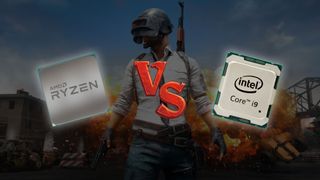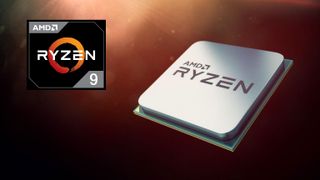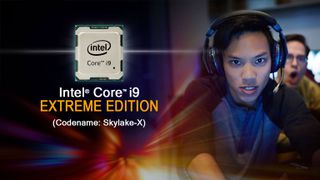Intel and AMD are about to clash with new high-end gaming CPUs
It's looking like a new battleground for enthusiast PCs.

Intel has been the undisputed king of the PC world for the past decade, but AMD's Ryzen has started to shake things up. Offering more cores for less money, Ryzen is the first AMD CPU since Sledgehammer (K8) in 2004 to seriously challenge Intel's best. Following the successful launch of Ryzen 7 and 5 (competitors for Intel's Core i5 and i7) and the AM4 platform, AMD is prepping its X399 chipset and Ryzen 9 CPUs, potentially doubling the core count of Ryzen 7. Intel isn't about to go quietly into the night, pulling out its own heavy artillery in the form of Core i9 Skylake-X and Core i7 Kaby Lake-X processors for the upcoming LGA2066 / X299 platform.
The high-end desktop market is set to become a new battleground for the PC enthusiast.
Supposed leaks from both companies surfaced over the past week, and like all leaks we should approach the numbers with caution. I've seen plenty of fabricated numbers and model names in the past (eg, no one got the GTX 1080 Ti specs right before launch), but the specificity of the Core i9 and Ryzen 9 models implies we're not dealing with random guesses. And I've heard enough from motherboard manufacturers to say that the platforms definitely exist and are likely to show up at Computex in early June. With that in mind, here's the big picture of what's happening in the high-end desktop realm.

AMD's Ryzen 9 and X399
AMD isn't content to remain a 'budget' brand, a painful distinction the company has been dealing with since it launched the Bulldozer architecture in 2011. The Ryzen CPUs haven't necessarily beat Intel in every situation, but from a value perspective the Ryzen 5 1600 and Ryzen 7 1700 are awesome products. Those chips come very close to matching Intel's i7-6800K and i7-6900K performance, at one-half to one-third the price—though with lower maximum overclocks. Doubling down on the number of Ryzen die in the package will allow AMD to have up to 16-core/32-thread parts, in what will reportedly be a massive 4094-pin package (compared to AM4's relatively tame 1331 pin package).
Just what the hell is AMD doing with all those pins? It's pretty simple, really: lots of memory channels and more PCIe lanes. The Ryzen 9 CPUs will use some derivative of AMD's Naples server product, only with half the cores (two Ryzen CPU die per package instead of four die). Naples can run up to 32-core/64-thread CPUs per socket, with eight memory channels and 128 PCIe lanes. Add all of that up and you get the 4094-pin requirement, and to avoid creating a third CPU socket, AMD will apparently leverage a modified SP3r2 for the high-end platform. Which means further down the road, we could conceivably get 32-core parts for the platform, but we're a long way off from needing such a configuration for even high-end desktops.
What does all of this mean for performance? Single-threaded results are unlikely to change, but with the right workload Ryzen 9 should show excellent multi-core scaling. We've seen this with Ryzen 7 already, and the Infinity Fabric that connects the CPU die and packages on Ryzen 9 should allow 16-core parts to nearly double (at the same clockspeed) the multi-threaded performance of 8-core parts.
For gaming, however, all those extra cores are likely going to waste. Very few games scale beyond 4-core/4-thread, and I'm not aware of any that really scale going from 6-core/12-thread to 8-core/16-thread—maybe Ashes of the Singularity: Escalation? If such a game exists, it's clearly in a very exclusive club, and I don't foresee most games pushing beyond 8-core/16-thread any time soon.
The biggest gaming news, reviews and hardware deals
Keep up to date with the most important stories and the best deals, as picked by the PC Gamer team.

Intel's Core i9/i7 and X299
Intel, on the other hand, is continuing down the expected path, with a few minor tweaks. Core i9 (if that rumored name ends up being true) is a rebranding of existing 6-core and higher parts, but by moving the new chips into a separate brand Intel makes it easier to determine chip capabilities from the part number. Prior to Core i9, Core i7 ran the gamut of everything from ULV dual-core chips for laptops, to quad-core laptop and desktop parts, and on to 6/8/10-core enthusiast chips. Going forward, all the enthusiast chips could now sit in the first class Core i9 cabin.
That's simple enough, but digging a little deeper into the leaked details on Skylake-X and Kaby Lake-X, there are some noteworthy changes if everything bears out.
By quadrupling the L2 cache size, Intel will keep the CPU pipelines running closer to capacity.
First is the CPU architecture, which expands from a 4-wide superscalar pipeline to a 6-wide design. This potentially improves performance by up to 20 percent over the Haswell/Broadwell architecture, though in practice it's more like a 10-15 percent improvement. If you're interested in learning more about the Skylake/Kaby Lake architecture, check out our Kaby Lake need to know and Processors Architecture 101 articles. Intel isn't content to just port Skylake/Kaby Lake over to the high-end market without making a few tweaks, however, the biggest being that L2 cache size has been quadrupled from 256kB to 1024kB.
Why does that matter? Cache is one of the main factors in keeping CPU cores fed with the data and instructions they need, when they need them. L1 cache provides information with effectively no pipeline stalls but is relatively small, while L2 cache has much more storage space but also higher latency (which means lost efficiency as the CPU cores wait for data to arrive from L2 cache). L3 cache repeats that pattern, with even more capacity and higher latency than L2, but it's still many times faster than waiting for DRAM to respond. By quadrupling the L2 cache size (assuming latency hasn't changed too much), Intel will keep the CPU pipelines running closer to capacity—possibly another 5-10 percent improvement in performance, depending on the workload.
Combine all of this with reported stock clockspeeds that are substantially higher, at least for maximum turbo clocks, and the Core i9 parts should prove potent for nearly any workload. The 10-core i7-6950X as an example has a base clock of 3.0GHz with a turbo clock of 3.5GHz, with Turbo Max allowing up to 4.0GHz on a single core with the right motherboard and BIOS settings. The new 10-core i7-7900X, assuming the leaked specs are correct, has a 3.3GHz base and a 4.3GHz maximum turbo, with Turbo Max allowing up to 4.5GHz.

AMD vs. Intel round 9: FIGHT!
What can we expect from AMD's renewed aggression in the high-end market? Ultimately, it will come down to two things: actual pricing and intended use.
For pure gaming use, the biggest factor will be per-core performance and clockspeed, at least for the near term. That means Intel will hold the advantage, as we'll likely see a clockspeed advantage of 300-500MHz (10 percent), along with an architectural advantage per core of around 10-15 percent. If you're putting together a gaming PC, even with multiple GPUs, don't expect Ryzen 9 to radically change the position of AMD's parts. For single-GPU users, you can see how GTX 1080 Ti performance differs between the Ryzen 7 (overclocked to 3.9GHz) and the Core i7-5930K (overclocked to 4.5GHz).
With both Ryzen 9 and Core i9 targeting the enthusiast market, I expect GTX 1080 Ti or RX Vega to be the minimum GPU most enthusiasts will use, meaning even if it costs hundreds of dollars more, Skylake-X will be the winner for gaming. Of course, if you're running at 4K, regardless of your GPU, you're still likely limited by graphics rather than CPU in most cases.
With more cores at every price point, Ryzen 9 should win a reasonable share of the multi-threaded benchmark metrics.
Outside of gaming, the story will be different. Even if Intel holds a moderate clockspeed and architecture advantage, AMD is more than happy to throw additional CPU cores at the problem. 4-core/8-thread Ryzen 5 against 4-core/8-thread i7-7700K ends up with Intel winning every benchmark, but at a higher price. At the same $330 price, however, Ryzen 7-1700 against the i7-7700K lets AMD smoke Intel in multi-threaded workloads like video editing. And at $500, AMD has a higher clocked 8-core/16-thread part going up against Intel's 6-core/12-thread parts—you'll pay twice as much for the CPU to get eight threads from Intel.
If the pricing pattern holds, I expect the 12-core Ryzen 9 chips to cost roughly the same as Intel's 8-core chips, and the 16-core Ryzen parts will probably cost half as much as the 12-core i9-7920X. And with more cores at every price point, Ryzen 9 should win a reasonable share of the multi-threaded benchmark metrics. AMD will still be offering the cheaper option—but in high-end parts instead of budget territory.
Intel may drop prices on the 8-core/10-core offerings to be more competitive, if it feels enough pressure from AMD, but Intel is also worried about cannibalizing sales of its lucrative Xeon server line. High performance 12-core Broadwell Xeons cost over $2000 right now, so more performance at a substantially lower price with Skylake-X may not happen. But servers and high-end desktops don't overlap too much, so one likely scenario is that the i9-7920X takes over the $1700 price point of the 10-core i7-6950X, the 10-core i9-7900X goes for the $1000 price point, and 8-core i9-7820X will land closer to $600. Pricing advantage still goes to AMD, however.
Assuming Ryzen 9 and Core i9 line up with what the rumor mill is saying (and the specs look pretty realistic), the new platforms and processors should continue with the current pattern. Intel will win its share of benchmarks, but often at a higher price, while AMD will perform well in scenarios where core counts are important. We should find out a lot more about official model numbers, prices, and launch dates at Computex, which kicks off at the end of May.
Jarred's love of computers dates back to the dark ages when his dad brought home a DOS 2.3 PC and he left his C-64 behind. He eventually built his first custom PC in 1990 with a 286 12MHz, only to discover it was already woefully outdated when Wing Commander was released a few months later. He holds a BS in Computer Science from Brigham Young University and has been working as a tech journalist since 2004, writing for AnandTech, Maximum PC, and PC Gamer. From the first S3 Virge '3D decelerators' to today's GPUs, Jarred keeps up with all the latest graphics trends and is the one to ask about game performance.
Most Popular

